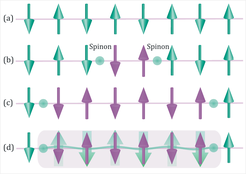Realization of a Tomonaga-Luttinger liquid in YbAlO3
In condensed matter physics, among the large number of well-studied theoretical models there are some that have very rare experimental realization. This is valid even for the simplest models like the one-dimensional (1D) antiferromagnetic (AFM) quantum spin ½ chains. This model can be well described by the exotic Tomonaga-Luttinger liquid (TLL) theory and exhibits exceptional properties, such as strong quantum fluctuations and the presence of so-called “spinons”. What are spinons? In conventional 3D magnets, in which the AFM ground state consists of a periodic arrangement of magnetic moments, an elementary excitation can be represented as a wave of small deflections of these moments from their initial position, or as a quasiparticle known as magnon which carries spin momentum S = 1. On the other hand, in the 1D case the situation is different: a magnon is “fractionalized” into two fermionic quasiparticles known as “spinons”. The process of creation of a spinons pair is schematically illustrated in Fig.1. These spinons can propagate freely (deconfined) along the AFM chain at temperature above the ordering temperature TN (Fig.1 b,c) while the presence of an effective internal field due to the intrachain interactions at T < TN confines the spinons (Fig.1 d) because their propagation will cost energy.

Recently, an international team of scientists from USA, China, Ukraine and Germany (MPI-CPfS Dresden) has demonstrated that, in the rare-earth quantum magnet YbAlO3 (with an AFM ordering temperature TN = 0.88 K), the TLL is experimentally realized. This was done by a combination of thermodynamic (at MPI-CPfS in Dresden) and spectroscopic (at Oak Ridge National Laboratory) measurements. The low-temperature magnetization measurements revealed a very strong uniaxial anisotropy of the Yb moments, which is induced by a combination of spin-orbit coupling and crystalline electrical field effect. On the other hand, results of inelastic neutron scattering above the ordering temperature show a gapless spinon continuum, dispersive along the direction of the Yb chains, indicating that the collective magnetic behavior is dominated by the highly isotropic Yb-Yb exchange interaction and forms a TLL state. Note that the combination of highly anisotropic magnetic moment of Yb and isotropic Yb-Yb exchange interaction is among the unique properties of YbAlO3 giving a rise to its unusual behavior and rich excitation spectra.
With decreasing temperature, a dipole-diople intrachain interaction confines the spinons and induces a simple long-range AFM ordering of the Yb moments. The application of a magnetic field, at first, creates an exotic longitudinal spin-density-wave phase, and with further increasing, destroys the long-range order at the quantum critical point (QCP). Most remarkably, thermodynamic properties of YbAlO3 near the QCP follow a universal behavior and the analysis of the scaling behavior and critical exponents indicates that the QCP is a free fermion fixed point, consistently with expectation for in the 1D TLL.
Results of presented study demonstrate that f-electron-based magnets can provide an experimental platform for realization of different aspects of quantum magnetism, such as spinon confinement-deconfinement transition and a quantum critical TLL behavior. More details can be found in https://doi.org/10.1038/s41467-019-08485-7.
NS / CPfS
